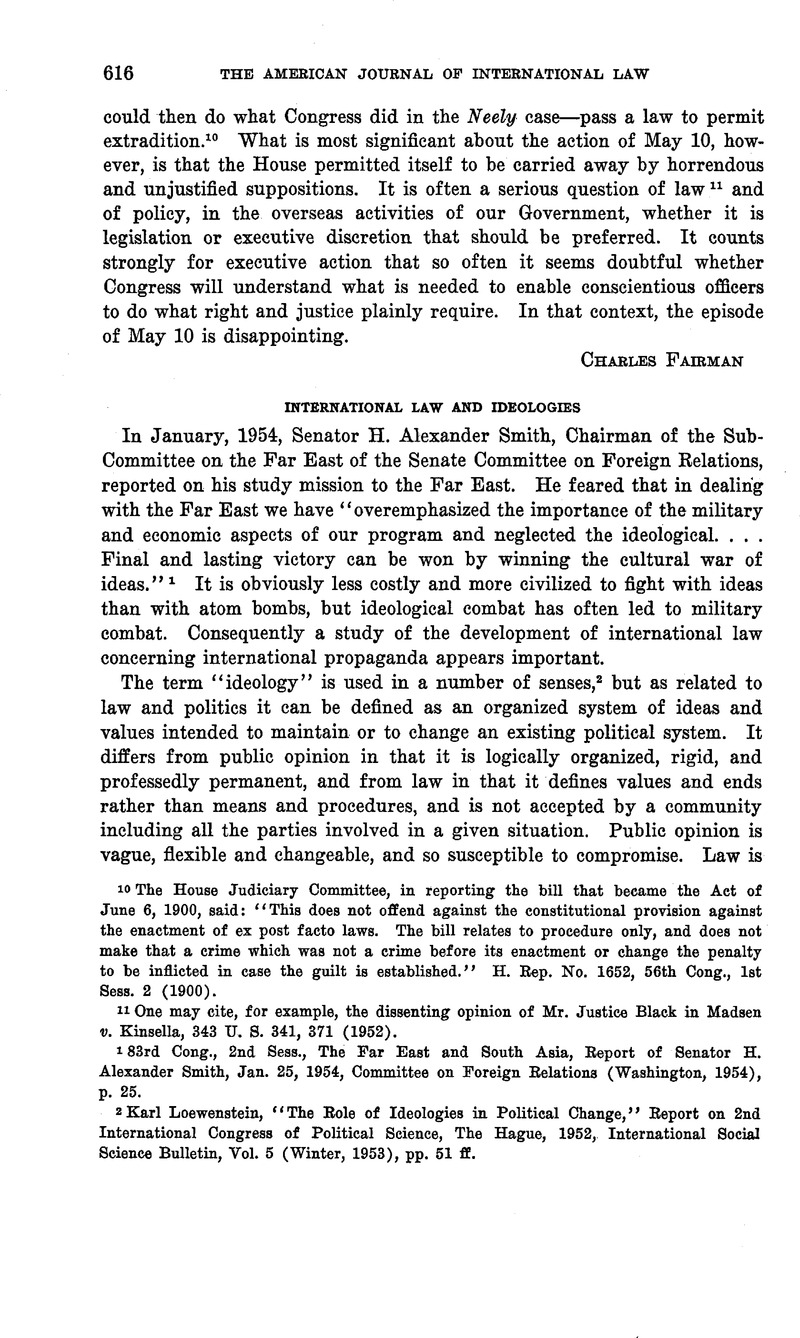Published online by Cambridge University Press: 30 March 2017

1 83rd Cong., 2nd Sess., The Far East and South Asia, Report of Senator H. Alexander Smith, Jan. 25, 1954, Committee on Foreign Eelations (Washington, 1954), p. 25.
2 Karl Loewenstein, “The Bole of Ideologies in Political Change,” Report on 2nd International Congress of Political Science, The Hague, 1952, International Social Science Bulletin, Vol. 5 (Winter, 1953), pp. 51 ff.
3 Wilk, Kurt, “International Law and Global Ideological Conflict, Reflections on the Universality of International Law,” this Joubnai , Vol. 45 (1951), pp. 648 ffGoogle Scholar.
4 Wright, Quincy, A Study of War (University of Chicago Press, 1942), p. 159 Google Scholar.
5 Department of State Bulletin, Vol. 28 (April 27, 1953), p. 599.
6 Francis of Victoria, On the Indians, sec. 3, par. 12 (Carnegie ed.), p. 157; Q. Wright, “Freedom and Responsibility in Respect to Trans-national Communication,” Proceedings, American Society of International Law, 1950, p. 97.
7 Emmerich de Vattel, The Law of Nations, Book II, Ch. 4, sees. 60–61 (Carnegie ed.), p. 133; Wright, loc. cit.
8 E. M. Borchard, “The Minimum Standard of the Treatment of Aliens,” Proceedings, American Society of International Law, 1939, pp. 51 ff.; Stowell, Ellery, International Law (New York, Holt, 1931), pp. 176 ff.Google Scholar; Wilson, R. R., The International Law Standard in Treaties of the United States (Cambridge, Harvard University Press, 1953), pp. 103 ffCrossRefGoogle Scholar.
9 Stowell, Ellery, Intervention in International Law (Washington, Byrne, 1921), pp. 51 ff.Google Scholar; International Law, op. cit., pp. 349 ff.
10 Tunis and Morocco Nationality Decrees, P.C.I.J. Eeports, 1923, Series B, No. 4, pp. 24 ff.; The Lotus, ibid., 1927, Series A, No. 10, p. 18; Hudson, World Court Reports, Vol. 1, pp. 156 ff., Vol. 2, pp. 34 ff.; Interpretation of Peace Treaties with Bulgaria, Hungary and Eumania, I.C.J. Reports, 1950, p. 65; this Journal, Vol. 44 (1950), p. 745.
11 Q. Wright, “Recognition and Self-Determination,” Proceedings, American Society of International Law, 1954, p. 23.
12 Contrasting treatments of the subject are illustrated by comparison of the section on the “duty of non-intervention” in George Grafton Wilson’s Handbook of International Law (3rd ed., St. Paul, West, 1939, pp. 58–65) with that on the “right of intervention” in Ellery Stowell’s International Law (op. cit., pp. 69–389).
13 Lauterpacht, H., “Revolutionary Activities of Private Persons against Foreign States,” this Journal , Vol. 22 (1928), pp. 105, 126 Google Scholar; Preuss, Lawrence, “International Eesponsibility for Political Propaganda against Foreign States,” ibid., Vol. 28 (1934), p. 649 Google Scholar; VanDyke, Vernon, “The Eesponsibility of States for International Propaganda,” ibid., Vol. 34 (1940), pp. 58, 73 Google Scholar, and “Autocratic Opposition to Freedom in Foreign States,” Journal of Politics, Vol. 4 (1942), pp. 437 ff.
14 Wright, Q., “The Outlawry of War,” this Journal , Vol. 19 (1925), pp. 89–94 Google Scholar.
15 Lauterpacht, loc. cit., note 13 above.
16 Resolution, Feb. 1, 1951, United Nations Bulletin, Vol. 5 (Feb. 15, 1951), p. 151.
17 This definition is implied in the Opinion of the Nuremberg Tribunal, see Wright, Q., “The Law of the Nuremberg Tribunal,” this Journal , Vol. 41 (1947), p. 66 Google Scholar, and is closely followed in the International Law Commission’s Draft Code of Offenses against the Peace and Security of Mankind (Art. 2, pars. 1–4). See Eeport, 3rd Sess., 1951, this Journal, Supp., Vol. 45 (1951), p. 126.
18 Above, note 7. See also Cowles, Willard B., “Meaning of Aggression in the United Nations Charter,” Nebraska Law Review, Vol. 3 (1954), pp. 606 ffGoogle Scholar.
19 Above, note 17.
20 Above, note 13; and Wright, Q., “The Denunciation of Treaty Violators,” this Jouenal , Vol. 32 (1938), pp. 526 ffGoogle Scholar.
20a Department of State Bulletin, Vol. 25 (Dec. 3, 24, 31, 1951), pp. 910, 1010, 1056; United Nations Bulletin, Vols. XI (Dec. 15, 1951), p. 492, XII (Jan. 1, 15, 1952), pp. 20, 59 ff.; International Organization, Vol. VI (May, 1952), p. 232.
21 Wright, Q., “The Crime of War-Mongering,” this Journal , Vol. 42 (1948), p. 132 Google Scholar; VanDyke, loc. cit., p. 71.
22 Ibid.
23 The United Nations International Law Commission included among offenses against the peace and security of mankind “The undertaking or encouragement by the authorities of a State of activities calculated to foment civil strife in another state, or the toleration by the authorities of a state of organized activities calculated to foment civil strife in another state.” Conspiracy, incitement, or attempts to commit such acts, and complicity in their commission, were also included. This Journal, Supp., Vol. 45 (1951), pp. 128–131. See also Wright, “The Crime of War-Mongering,” loc. cit.
24 United Nations Weekly Bulletin, Nov. 11, 1947, p. 618.